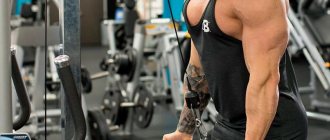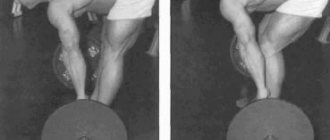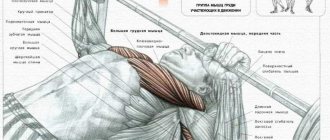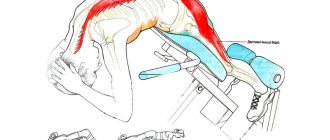Hyperextension is the most effective exercise that strengthens and develops the spinal muscles located in the lumbar region. This type of training is especially popular among women who want to reduce the size of their belly.
The purpose of the exercise is to train the biceps, semitendinosus and semimembranosus femoris muscles, as well as the gastrocnemius and gluteus maximus muscle groups. Hyperextension exercises are recommended for sedentary people and beginner athletes.
The exercise is contraindicated for people suffering from spinal diseases.
The effectiveness of the exercise is ensured by its regular and technically competent execution over a period of 3-4 weeks.
Why is hyperstension needed?
Hyperextension is essentially flexion and extension of the back on a special machine - popularly called a “Roman chair”. During training, the muscles of the thighs, buttocks, lower legs, and lower back actively work, which has a healing and general strengthening effect for the lumbar girdle, allows you to correct your figure, get abs and a flat stomach, elastic buttocks, a wasp waist, and remove “ears” from the sides.
The body solid ghyp 45 incline exercise machine is convenient for independent training.
Anatomical atlas
The set of muscles that are involved in the hyperextension exercise is very useful for the spine; in addition to the main groups, the work includes muscles connected to the column of the spine, which cannot be worked with other movements. This is a universal workout for creating a muscle corset that will serve as powerful and reliable protection for the lumbar region and protect you from spinal injuries. The table below shows how the load is created when performing the hyperextension exercise, which muscles work:
| Muscle name | Where is it located? | How it works |
| Rear end | ||
| Biceps femoris or biceps muscle | From the back of the thighs, from the outer side | Bends the legs at the knees, straightens the hip joint, raising the torso |
| Semitendinosus | Located at the back, on the inside | |
| Semimembranosus | Located under the semitendinosus muscle | |
| Lower leg and buttocks | ||
| Gastrocnemius | Ankle, back | Fixes the ankle joint, bends the knees |
| Gluteus maximus | Buttocks | Raising the torso from a bend, extends the hip joint |
The muscle groups that bear the main load.
Watch the lesson “technique for performing hyperextension”; the video shows in detail how to correctly perform exercises on the machine.
[su_youtube url=”https://www.youtube.com/watch?v=ykGsGlXkEVg”]
Types of hyperextensions
There are several types of exercises, their name determines the essence of the exercise:
- at an angle – inclined hyperextension, simulator at an angle of 45o;
- parallel to the floor - horizontal hyperextension, classic exercise;
- reverse hyperextension – the torso is motionless, the legs are included in the work;
- hyperextension on a fitball - a large ball.
How to properly do hyperextension on an incline machine.
The exercise can be done even on the floor, without a Roman chair. Next, a master class on how to perform hyperextension correctly, video advice from professionals and an analysis of the main mistakes.
[su_youtube url=”https://www.youtube.com/watch?v=JWdoutDDT8s”]
Hyperextension – training program
The exercise must be included in a complex aimed at working the back. Horizontal hypertension, on the advice of trainers, should be performed at the end of the complex, and the reverse, on the contrary, before basic exercises. The number of repetitions and additional weight used should be selected depending on the goal. As an example, you can focus on the recommendations presented in the form of a table.
| Target | Weight from maximum | Approaches | Repetitions |
| Increased Strength | 85-100% | 2-6 | 1-5 |
| Development of the muscle corset | 60-85% | 3-6 | 6-12 |
| Drying | 40-60% | 2-4 | 12-25 |
Apr 2, 2017Olga
Techniques for performing hyperextension
All classic hyperextension exercises are for the back, and only the reverse one involves the gluteal region to a greater extent. In addition to special exercise machines, classes can be carried out on a bench, on a ball, or lying on the floor.
Hyperextension trainer torneo g 104 – light and compact, convenient for home training
On a special bench
Horizontal hyperextension is performed on the bench, the technique is the same as on the simulator. The legs of the bench are attached to the floor for stability. An assistant should hold your legs. We lie on our stomachs on the bench and slide onto the end edge until we reach our hips so that our torso hangs completely down.
Good to know: The higher the bench, the greater the range of motion, the more effective the training.
The body is strictly horizontal, the back is straight, hands behind the head or crossed in front of you. Slowly, while inhaling, bend down until you feel strong tension in the hips. As you exhale, we slowly rise up. The main condition is that the back must be straight, it cannot be arched or rounded, and swaying of the body is prohibited.
Hyperextension, photo of the correct body position during exercises
On the floor
Hyperextension on the floor is often performed at home, without special equipment. We lie on our stomachs, stretch our arms forward, and keep our back straight. As you inhale, we try to slowly lift your legs off the floor, as high as possible, and as you exhale, we take the starting position.
Then we fix the legs; an assistant can hold your ear or put your feet under the sofa. We clasp our hands behind our heads, inhale and at this time begin to lift our torso up, exhale and lower ourselves down.
The photo shows how to do hyperextension at home
On fitball
Exercises on the ball do not allow you to use significant weight in the workout. Hyperextension on a fitball is complicated by the fact that coordination of movements is required.
We lie face down, the ball in the stomach, arms behind our heads or crossed in front of us, keeping our legs straight, resting our toes on the floor. As we inhale, we strain the muscles of the lumbar region, straighten our back to the limit so that our legs and spine form one straight line. As you exhale, twist downwards.
Hyperextension, technique of performing on a fitball
Reverse hyperextension
Reverse hyperextension helps to work the hamstrings and gluteal muscles, and optionally distributes the load to the long dorsal muscles. This exercise helps stretch the spinal column. Essentially, reverse hyperextension involves the same areas as the classic version of the exercise, but the emphasis is slightly shifted. It is believed that this training option is safer for the spine.
It is convenient to do the reverse exercise on a folding, weight-block aliv sport al 018
The exercise is performed on a simulator or on a special board, which is fixed exactly at the level of the abdomen. The reference point is the middle and upper abdominal area, up to the navel. We lie with our chests on the board, hold on tightly with our hands, raise our legs up, ideally above the lower back, in order to maximally load the muscles. We hold the position for a couple of seconds and slowly lower our legs down. To make the exercise more difficult, you can tie dumbbells or a weight plate to your legs.
Hyperextension for the buttocks, one way to perform the reverse exercise
Important: Working with weights is only recommended for already trained people in good physical shape.
Reverse hyperextension
It differs from the classics in that the body is fixed, and the legs work directly, which bear the greatest load.
The gluteus maximus muscles and hips are especially strong. This exercise is popular among girls because it allows you to work out the contour of the buttocks, making them aesthetically pleasing and toned.
It is recommended to perform the exercise as a warm-up before deadlifting. This will make lifting the bar easier and safer.
The main advantage of reverse hyperextension is that it does not overload the lower back and back, so if you have problems with the spine, you should pay attention to it. Also, when performing this exercise, you can use more weight than with the classic version, since the load is removed from the lower back.
To do it, you need:
- Lie down on a bench, Roman chair or other horizontal or inclined surface and firmly grasp the machine with your hands. The top points of the buttocks should be above the edge of the machine.
- Raise your legs slightly, feeling the tension in your buttocks and thighs.
- Exhale while raising your legs as high as possible. It is important to ensure that the same muscles remain tense.
- Hold for a couple of seconds at the top point.
- Slowly lower your legs back, taking a deep breath.
It is recommended to perform two or three approaches, each with about 15 repetitions. You need to rest for a minute between sets.
When performing reverse hyperextensions, it is extremely important not to spread your legs. This will not increase the load on the muscles and may cause joint injuries.
Hyperextension at home
Hyperextension at home can be performed on the floor, on a fitball; for those who cannot imagine their life without sports, it is better to buy a machine or make a bench with your own hands. For beginners, it is recommended to start on the floor; the exercises can be performed even on a hard sofa or chair.
Here it is important to consider safety precautions and a way to hold your legs without an assistant to perform classic hyperextension. If you follow the technique, the results at home are not inferior to those that can be achieved in the gym. It is better to do it several times, the optimal number of approaches is 3 times, 15-20 twists.
Description of the simulator
This exercise must be performed using a special simulator. Thanks to the exercise machine, the lumbar part is perfectly strengthened. All this is done as comfortably and painlessly as possible. Training on the simulator is important for beginner athletes and for those who are contraindicated for placing too much stress on the spine. The convenient design system of the simulator combines unloading and decompression of the lumbar spine in one exercise.
Externally, these exercise machines resemble an inclined bench with a special leg lock. The exercise machines have height and angle adjustments, allowing different muscle groups to be trained. Complete safety and convenience is achieved due to isolated movement.
Is it possible to do hyperextension with a problem spine?
The main contraindication for hyperextension is any problems in the spine. But there are practically no healthy people, so you can exercise, except for specific contraindications, which we will discuss below, but in a gentle manner, without additional stress.
What does hyperextension give:
- maintains muscle tone;
- strengthens the spine;
- relieves pain symptoms in the lumbar region;
- is a good preventative for intervertebral hernias;
- nutrition of muscle mass is enhanced.
Important: Lowering the body by more than 60 degrees is recommended only for trained people with a perfectly healthy and trained back. In any other cases, this position of the body during training will only cause harm.
Professional bench for hyperextension
It is difficult to track the correct technique on your own; either a stick attached to your back or training in the gym under the supervision of an instructor will help.
It is forbidden to perform hyperextension in case of any pain syndromes in the lower back and spine, even if they appeared during exercise; training should be stopped until the pain disappears. The safest option is hyperextension with the use of the rectus dorsi muscles, when the height of the support is located exactly at the level of the subgluteal fold, the back of the thigh and buttocks are dynamic, the extensor muscles of the back are static in this position. This position does not cause hyperextension, the natural deflection is maintained and the back is not rounded, there is no axial load.
Spinal problems include the following ailments:
- Sprained intervertebral ligaments.
- Back muscle strains (myositis).
- A protrusion of an intervertebral disc is a protrusion.
- A herniated intervertebral disc; an absolute contraindication is a hernia on a thin stalk, from the back of the spine; during training, it can fall off, get into the spinal canal, and put pressure on the nerves.
- Osteochondrosis without pain syndrome, you can exercise, you should choose exercises for the rectus dorsi muscles, physical therapy also includes the hyperextension exercise, without bending back.
- Sciatica is inflammation or pinching of the sciatic nerve.
- Mechanical injuries of the spinal column.
- Curvatures of the spine - scoliosis, hyperstension in a gentle manner is useful.
Before any sports activities, it is necessary to undergo a medical examination and obtain recommendations from specialists.
[su_youtube url=”https://www.youtube.com/watch?v=Bz8iXioTu6k”]
Hyperextension - benefits and harms
Each exercise has its own advantages and disadvantages that must be taken into account. The results depend on the correct execution of hyperextension, since even small deviations from the norm can cause injury, and in this case there is no need to talk about positive changes. For those who are interested in what hyperextension does, it will be interesting to know that it is useful to perform exercises for people who want to get rid of excess weight and improve the definition of their body.
Hyperextension - benefits
In addition to the fact that the exercise is effective for working the muscles of the back surface of the body, it has other benefits:
- When performed without additional weight and in combination with abdominal training, you can get rid of pain in the lower back.
- By regularly performing hyperextension, you can maintain the tone of the muscle corset and strengthen the spine.
- It is believed that proper exercise is an excellent prevention of intervertebral hernia.
- It is recommended to do such movements for people who lead a sedentary lifestyle, since their muscles lose their elasticity and become weak.
- When figuring out why hyperextension is useful, you should point out that it will be an excellent warm-up before heavy exercises for developing back muscles, for example, before deadlifts.
Hyperextension is harmful
The exercise is contraindicated for people who have serious problems with the spine. In any case, before moving on to intense training, you should consult your doctor. Hyperextension can cause harm to the spine if performed incorrectly, so the most common mistakes include: strong bending in the spine during lifting, deep bending forward, bending the knees, throwing the head back and using excessive load.
Choosing a machine for hyperextension training
For more effective training, you need a hyperextension trainer; you can buy it in sporting goods stores or in a specialized online store, the average price is $60-400. Before you make a purchase, there are a few things you need to know about a Roman chair.
Hyperextension body craft f670, adjustable leg clamp: 15 levels in height and 5 in length
Horizontal and inclined equipment are offered for sale; more advanced models allow you to adjust the bench height according to your height. The design also provides two pillows on one side for a comfortable position of the hips and bolsters for holding the legs.
Convenient folding oxygen hyperpress board exercise machine, weighs only 13 kg
Good to know: The inclined version can be turned into a horizontal one by attaching a stand to the rear legs, so you can install the exercise machine at any angle. In addition to a purchased machine, they can serve as a box, board, shield, etc.
Wide professional machine aerofit if45
Before purchasing, make sure that there is enough distance between the bench and the leg bolsters for your anthropometric data. If the machine does not fit in size, then it will be inconvenient to practice.
Budget bench for training back and abdominal muscles dfc sc yw011










